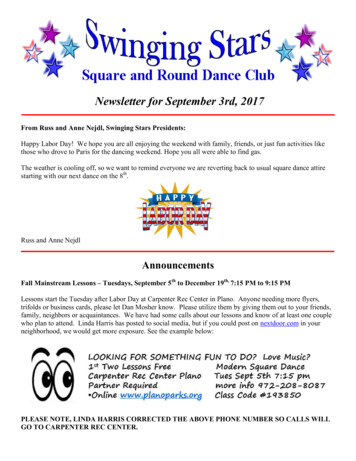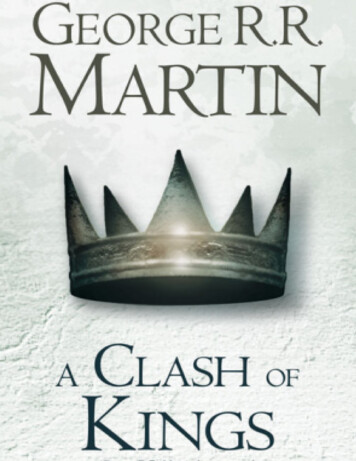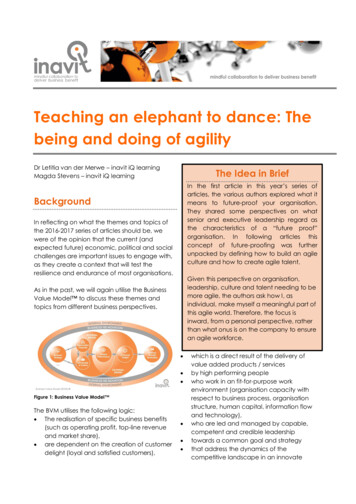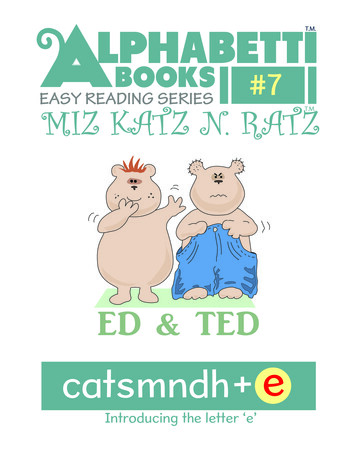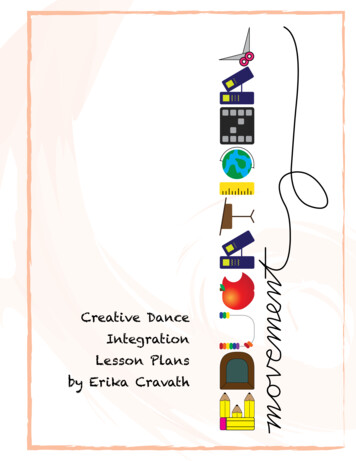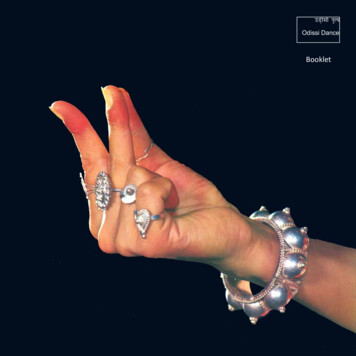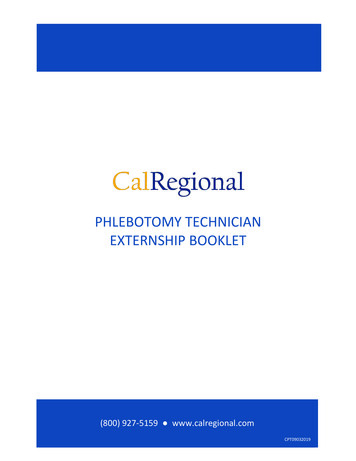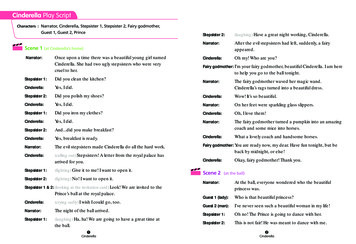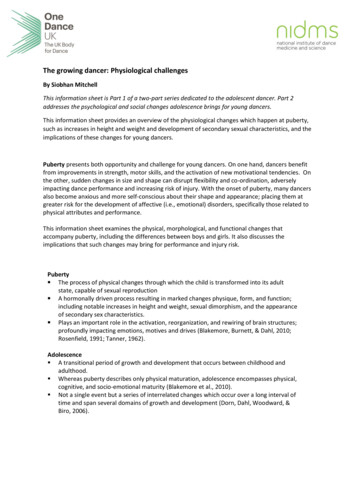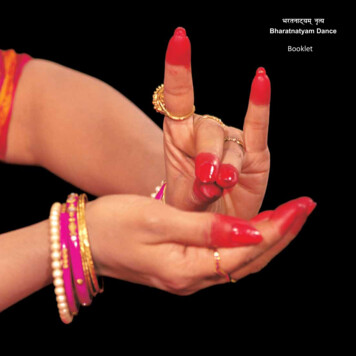
Transcription
HkjrukV ;e u R;Bharatnatyam DanceBooklet
Hkkjr esa u R; cgqr izkphu dky ls ,d le ¼ vkSj thoar ijEijk jgk gSAfofHkUu dkyksa dh [kqnkbZ] f'kykys[kksa] ,sfrgkfld o.kZu] jktkvksa dh oa'k&ijEijkrFkk dykdkjksa] lkfgfR;d Ïksrksa] ewfrZdyk vkSj fp kdyk ls O;kid izek.kmiyCèk gksrs gSaA ikSjkf.kd dFkk,a vkSj nardFkk,a Hkh bl fopkj dk leFkZu djrhgSa fd Hkkjrh; turk osQ èkeZ rFkk lekt esa u R; us ,d egRoiw.kZ LFkku cuk;kFkkA tcfd vkt izpfyr 'kkL kh;* :iksa ;k dyk* osQ :i esa ifjfpr fofoèku R;ksa osQ fodkl vkSj fuf'pr bfrgkl dks lhekafdr djuk vklku ugha gSADance in India has a living tradition dating back to ancient times.Excavations, inscriptions, chronicles, genealogies of kingsand artists, literary sources, sculpture and painting of differentperiods provide extensive evidence on dance. Myths andlegends also support the view that dance had a significant placein the religious and social life of the Indian people. However, it isnot easy to trace the precise history and evolution of the variousdances known as the ‘art’ or ‘classical’ forms popular today.lkfgR; esa igyk lanHkZ osnksa ls feyrk gS] tgka u R; o laxhr dk mn xe gSAu R; dk ,d T;knk la;ksftr bfrgkl egkdkO;ksa] vusd iqjk.k] dfoRo lkfgR;rFkk ukVdksa dk le ¼ dks"k] tks laLÑr esa dkO; vkSj ukVd osQ :i esa tkustkrs gSa] ls iqu u er fd;k tk ldrk gSA 'kkL kh; laLÑr ukVd Mªkek dkfodkl ,d o .kr fodkl gS] tks eq[kfjr 'kCn] eqnzkvksa vkSj vkÑfr] ,sfrgkfldo.kZu] laxhr rFkk 'kSyhxr xfrfofèk dk ,d lfEeJ.k gSA ;gka 12 oha lnh ls19oha lnh rd vusd izknsf'kd :i gSa] ftUgsa laxhrkRed [ksy ;k laxhr&ukVddgk tkrk gSA laxhrkRed [ksyksa esa ls orZeku 'kkL kh; u R;&:iksa dk mn;gqvkAIn literature, the first references come from the Vedas wheredance and music have their roots. A more consistent history ofdance can be reconstructed from the epics, the several puranasand the rich body of dramatic and poetic literature known as thenataka and the kavya in Sanskrit. A related development wasthe evolution of classical Sanskrit drama which was an amalgamof the spoken word, gestures and mime, choreography, stylisedmovement and music. From the 12th century to the 19th centurythere were many regional forms called the musical play orsangeet-nataka. Contemporary classical dance forms are knownto have evolved out of these musical plays.[kqnkbZ ls nks ew r;k¡ izdk'k esa vkb &,d eksgutksnM ksa dky dh dkals dh ewfrZvkSj nwljk gM Iik dky (2500&1500 bZlk iwoZ) dk ,d VwVk gqvk èkM A ;snksuksa u R; eqnzkvksa dh lwpd gSaA ckn esa uVjkt vkÑfr osQ vxznwr osQ :i esabls igpkuk x;k] ftls vke rkSj ij u R; djrs gq, f'ko osQ :i esa igpkuktkrk gSAExcavations have brought to light a bronze statuette fromMohenjodaro and a broken torso from Harappa (dating back to2500–1500 B.C.). These are suggestive of dance poses. Thelatter has been identified as the precursor of the Nataraja posecommonly identified with dancing Siva.gesa Hkjreqfu dk ukV ;'kkL k] 'kkL kh; u R; ij izkphu xzaFk osQ :i esa miyCèkgS] tks ukVd] u R; vkSj laxhr dh dyk dh Ïksr&iqLrd gSA vkerkSj ij ;gLohdkj fd;k tkrk gS fd nwljh lnh bZlkiwoZ & nwljh lnh bZloh lu bl dk;Zdk le; gSA ukV ; 'kkL k dks ikaposa osn osQ :i esa Hkh tkuk tkrk gSA ys[kdosQ vuqlkj mlus bl osn dk fodkl ½Xosn ls 'kCn] lkeosn ls laxhr] ;tqosZnls ps"Vk,a vkSj vFkoZosn ls Hkko ysdj fd;k gSA ;gka ,d nardFkk Hkh gS fdHkxoku czg ek us Lo;a ukV ; osn fy[kk gS] ftlesa 36]000 'yksd gSaAukV ;&'kkL k esa lw kc¼ 'kkL kh; ijEijk dh 'kSyh esa u R; vkSj laxhr ukVd osQvya?kuh; Hkkx gSaA ukV ;dyk esa blosQ lHkh ekSfyd va'kksa dks j[kk tkrk gSvkSj dykdkj Lo;a urZd rFkk xk;d gksrk gSA izLrqrdÙkkZ Lo;a rhuksa dk;ks dksla;ksftr djrk gSA le; osQ lkFk&lkFk vius vki ukV ; ls vyx gks x;k vkSjLora k rFkk fof'k"V dyk osQ :i esa izfrf"Br gqvkAizkphu 'kksèk&fucaèkksa osQ vuqlkj u R; esa rhu igyqvksa ij fopkj fd;k tkrkgS& ukV ;] u R; vkSj u Rr A ukV ; esa ukVdh; rRo ij izdk'k Mkyk tkrk gSAdFkdyh u R;&ukVd :i osQ vfrfjDr vkt vfèkdka'k u R;&:iksa esa bl igywdks O;ogkj esa yk;k tkrk gSA u R; ekSfyd vfHkO;fDr gS vkSj ;g fo'ks"k :ils ,d fo"k; ;k fopkj dk izfriknu djus osQ fy, izLrqr fd;k tkrk gSA u Rrnwljs :i esa 'kq¼ u R; gS] tgka 'kjhj dh xfrfofèk;ka u rks fdlh Hkko dk o.kZudjrh gSa vkSj u gh os fdlh vFkZ dks izfrikfnr djrh gSaA u R; vkSj ukV ; dksizHkkodkjh ax ls izLrqr djus osQ fy, ,d urZdh dks uojlksa dk lapkj djusesa izoh.k gksuk pkfg,A ;g uojl gSa& Ük axkj] gkL;] d#.kk] ohj] jkSnz] Hk;]ohHkRl] vn Hkqr vkSj 'kkarAlHkh 'kSfy;ksa }kjk izkphu oxhZdj.k&rkaMo vkSj ykL; dk vuqdj.k fd;k tkrkgSA rkaMo iq#"kksfpr] ohjksfpr] fuHkhZd vkSj vkstLoh gSA ykL; L kh;ksfpr] dksey]The earliest treatise on dance available to us is Bharat Muni’sNatya Shastra, the source book of the art of drama, dance andmusic. It is generally accepted that the date of the work is betweenthe 2nd century B.C. and the 2nd century A.D. The Natya Shastrais also known as the fifth Veda. According to the author, he hasevolved this Veda by taking words from the Rig Veda, music fromthe Sama Veda, gestures from the Yajur Veda and emotions fromthe Atharva Veda. There is also a legend that Brahma himselfwrote the Natya Veda, which has over 36000 verses.In terms of the classical tradition formulated in the Natya Shastra,dance and music are an inextricable part of drama. The art ofnatya carries in it all these constituents and the actor is himselfthe dancer and the singer, the performer combined all the threefunctions. With the passage of time, however, dance weaneditself away from natya and attained the status of an independentand specialised art, marking the beginning of the ‘art’ dance inIndia.As per the ancient treatises, dance is considered as havingthree aspects : natya, nritya and nritta. Natya highlights thedramatic element and most dance forms do not give emphasisto this aspect today with the exception of dance-drama formslike Kathakali. Nritya is essentially expressional, performedspecifically to convey the meaning of a theme or idea. Nritta onthe other hand, is pure dance where body movements do notexpress any mood (bhava), nor do they convey any meaning. Topresent nritya and natya effectively, a dancer should be trained tocommunicate the navarasas. These are : love (shringara), mirth(hasya), compassion (karuna), valour (veer), anger (raudra),fear (bhaya), disgust (vibhatsa), wonder (adbhuta) and peace(shanta).
y;kRed vkSj laqnj gSA vfHku; dk foLrkfjr vFkZ vfHkO;fDr gSA ;g vkafxd]'kjhj vkSj vaxksa okfpd] xk;u vkSj dFku vkgk;Z] os'kHkw"kk vkSj vyadkj vkSjlkfRod] Hkkoksa vkSj vfHkO;fDr;ksa osQ }kjk lEikfnr fd;k tkrk gSAHkjr vkSj uafnosQ'oj&nks izeq[k xazFkdkjksa us u R; dk dyk osQ :i esa fopkj fd;kgS] ftlesa ekuo&'kjhj dk mi;ksx vfHkO;fDr osQ :i esa fd;k tkrk gSA 'kjhj(vax) osQ izeq[k ekuoh; vaxksa dh flj] èkM ] mQijh vkSj fupys vaxksa osQ :iesa rFkk NksVs ekuoh; Hkkxksa (mikaxksa) dh ksM h ls ysdj Hkoksa rd psgjs osQ lHkhHkkxksa rFkk vU; NksVs tksM ksa osQ :i esa igpku dh tkrh gSAukV ; osQ nks vfrfjDr igyw] izLrqrhdj.k vkSj 'kSyh osQ izdkj gSaA ;gkaizLrqrhdj.k osQ nks izdkj gSa] ftuosQ uke gSa&ukV ;èkehZ] tks jaxeap dk vkSipkfjdizLrqrhdj.k gS vkSj nwljk yksdèkehZ] dbZ ckj yksd] ;FkkFkZoknh] izÑfroknh ;kizknsf'kd osQ :i esa vuqokfnrA 'kSyh ;k o fÙk dks pkj Hkkxksa esa oxhZÑr fd;ktk ldrk gS&oSQldh] ykL; igyw osQ lapkj esa T;knk vuq:i] n{k xhfrdkO;vjcrh] vkstLoh iq#"kksfpr lrorh] tc jklksa dk fp k.k fd;k tkrk gS] rcvDlj bldk mi;ksx fd;k tkrk gS vkSj Hkkjrh lkfgfR;d fo"k;oLrqA'krkfCn;ksa osQ fodkl osQ lkFk Hkkjr esa u R; ns'k osQ fofHkUu Hkkxksa esa fodflrgqvkA budh viuh i Fkd 'kSyh us ml fo'ks"k izns'k dh laLÑfr dks xzg.k fd;kizR;sd us viuh fof'k"Vrk izkIr dhA vr% dyk* dh vusd izeq[k 'kSfy;ka cuhaftUgsa ge vkt HkjrukV ;e ] dFkdyh] oqQphiqM h] dFkd] ef.kiqjh vkSj vksfM lhosQ :i esa tkurs gSaA ;gka vkfnoklh vkSj xzkeh.k {ks kksa osQ u R; rFkk izknsf'kdfofoèkrk,a gSa] tks ljy] ekSle osQ g"kZiw.kZ lekjksgksa] iQly vkSj ,d cPps osQtUe osQ volj ls lEcfUèkr gSaA ifo k vkRekvksa osQ vkg oku vkSj nq"V vkRekvksadks 'kkar djus osQ fy, Hkh u R; fd, tkrs gSaA vkt ;gka vkèkqfud iz;ksxkRedu R; osQ fy, Hkh ,d lEiw.kZ uo fudk; gSAAn ancient classification followed in all styles is of Tandava andLasya. Tandava, the masculine, is heroic, bold and vigorous.Lasya, the feminine is soft, lyrical and graceful. Abhinaya,broadly means expression. This is achieved through angika, thebody and limbs; vachika, song and speech; aharya, costumeand adornment; and satvika, moods and emotions.Bharata and Nandikesvara, the two main authorities conceiveof dance as an art which uses the human body as a vehicleof expression. The major human units of the body (anga) areidentified as the head, torso, the upper and lower limbs, and theminor human parts (upangas), as all parts of the face rangingfrom the eyebrow to the chin and the other minor joints.Two further aspects of natya are the modes of presentationand the style. There are two modes of presentation, namely theNatyadharmi, which is the formalised presentation of theatre andthe Lokadharmi sometimes translated as folk, realistic, naturalisticor regional. The style or vrittis are classified into Kaiseki, the deftlyrical more suited to convey the lasya aspects, the Arbati, theenergetic masculine, the Satawati, often used while depictingthe rasas and the Bharati, the literary content.Nurtured for centuries, dance in India has evolved in different partsof the country its own distinct style, taking on the culture of thatparticular region, each acquiring its own flavour. Consequently,a number of major styles of ‘art’ or dance are known to us today,like Bharatnatyam, Kathakali, Kuchipudi, Kathak, Manipuri andOdissi. Then there are regional variations, the dances of ruraland tribal areas, which range from simple, joyous celebrationsof the seasons, harvest or birth of a child to dances for thepropitiation of demons or for invoking spirits. Today there is alsoa whole new body of modern experimental dance.
HkjrukV ;e u R;HkjrukV ;e u R; 2000 lky ls O;ogkj esa gSA Hkjreqfu osQ ukV ;'kkL k (200bZlk iwoZ ls 200 bZloh lu ) osQ lkFk izkjEHk gq, vusd xzaFkksa (iqLrdksa) lsbl u R; :i ij tkudkjh izkIr gksrh gSA uafnosQ'oj }kjk jfpr vfHku; niZ.kHkjrukV ;e u R; esa] 'kjhj dh xfrfof/ osQ O;kdj.k vkSj rduhdh vè;;u osQfy, xzaFkh; (iqLrdh;) lkexzh dk ,d izeq[k lzksr gSA ;gka izkphu dky dhèkkrq vkSj iRFkj dh izfrekvksa rFkk fp kksa esa bl u R; :i osQ foLr r O;ogkj osQn'kZuh; izek.k Hkh feyrs gSaA fpnEcje eafnj osQ xksiqjeksa ij HkjrukV ;e u R;dh Hkafxekvksa dh ,d Ük a[kyk vkSj ewfrZdkj }kjk iRFkj dks dkV dj cukbZ xbZizfrek,a ns[kh tk ldrh gSaA vusd eafnjksa esa ewfrZdyk esa u R; osQ pkjh vkSj d.kkZdks izLrqr fd;k x;k gS vkSj buls bl u R; dk vè;;u fd;k tk ldrk gSAHkjrukV ;e u R; dks ,dgk;Z osQ :i esa Hkh tkuk tkrk gS] tgka urZdh ,dyizLrqfr esa vusd Hkwfedk,a djrh gS] ;g dgk tkrk gS fd 19oha lnh osQ vkjEHkesa] jktk ljiQksth osQ laj{k.k osQ rgr ratkSj osQ izfl¼ pkj HkkbZ;ksa us HkjrukV ;e osQ ml jaxiVy dk fuekZ.k fd;k Fkk] tks gesa vkt fn[kkbZ nsrk gSAnsonkfl;ks }kjk bl 'kSyh dks thfor j[kk x;kA nsonklh okLro esa os ;qofr;kagksrh Fkha] tks vius ekrk&firk }kjk eafnj dks nku esa ns nh tkrh Fkha vkSj mudkfookg nsorkvksa ls gksrk FkkA nsonkfl;ka eafnj osQ izkax.k esa] nsorkvksa dks viZ.kosQ :i esa laxhr o u R; izLrqr djrh FkhaA bl lnh osQ oqQN izfl¼ xq#vksa vkSjvuqikydksa (urZd o urZfd;ksa) dk lacaèk nsonklh ifjokjksa ls gS] ftuesa ckykljLorh ,d cgqr ifjfpr uke gSAHkjrukV ;e dk jaxiVy cgqr foLr r gksrk gS] kaps dk vuqdj.k fd;k tkrk gSA lcls igysu R; ,dd vykfjIiw gS] ftldk 'kkfCnd vFkZv{kjksa osQ iBu osQ lkFk 'kq¼ u R; la;kstu dktcfd izLrqrhdj.k esa fu;fer;gka Lrqfr&xku gksrk gSA igykgSµiwQyksa ls ltkoVA ;g èofu,d vewrZ [k.M gSAvxyk ,dd] tkfrLoje ,d y?kq 'kq¼ u R; [k.M gS] tks dukZVd laxhrosQ fdlh jkx osQ laxhrkRed Lojksa osQ lkFk izLrqr fd;k tkrk gSA tkfrLoje esa lkfgR; ;k 'kCn ugha gksrs ij vM ow dh jpuk dh tkrh gS] tks 'kq¼ u R;Øe&u R; gksrs gSaA ;g HkjrukV ;e u R; esa izf'k{k.k osQ vkèkkjHkwr izdkj gSaAHkjrukV ;e dh ,d ,dy u R; vkSj cgqr vfèkd qdko vfHku; ;k u R; osQLokax igys&u R; ij gksrk gS] tgka urZdh xfrfofèk vkSj Lokax }kjk lkfgR; dksvfHkO;Dr djrh gSA HkjrukV ;e u R; osQ ,d izn'kZu esa tkfrLoje dk vuqlj.k'kCne }kjk fd;k tkrk gSA lkFk esa xk;k tkus okyk xhr vkerkSj ij loksZPplRrk (bZ'oj) dh vkjkèkuk gksrh gSABharatnatyam DanceBharatnatyam Dance is considered to be over 2000 years old.Several texts beginning with Bharata Muni’s Natya Shastra(200 B.C. to 200 A.D.) provide information on this dance form. TheAbhinaya Darpana by Nandikesvara is one of the main sourcesof textual material, for the study of the technique and grammarof body movement in Bharatnatyam Dance. There is also a greatdeal of visual evidence of this dance form in paintings and stoneand metal sculptures of ancient times. On the gopurams of theChidambaram temple, one can see a series of Bharatnatyamposes, frozen in stone as it were, by the sculptor. In many othertemples, the charis and karanas of the dance are represented insculpture and one can make a study of the dance form.Bharatnatyam dance is known to be ekaharya, where one dancertakes on many roles in a single performance. In the early 19thcentury, the famous Tanjore Quartette, under the patronage ofRaja Serfoji are said to have been responsible for the repertoireof Bharatnatyam dance as we see it today.The style was kept alive by the devadasis, who were young girls‘gifted’ by their parents to the temples and who were married tothe gods. The devadasis performed music and dance as offeringsto the deities, in the temple courtyards. Some of the renownedperformers and gurus of the early part of the century belong tothe devadasi families, a well-known name is Bala Saraswati.The repertoire of Bharatnatyam is extensive, however, aperformance follows a regular pattern. At first there is aninvocation song. The first dance item is the alarippu, literallymeaning-to adorn with flowers. It is an abstract piece combiningpure dance with the recitation of sound syllables.The next item, the jatiswaram is a short pure dance pieceperformed to the accompaniment of musical notes of any ragaof Karnataka music. Jatiswaram has no sahitya or words, but iscomposed of adavus which are pure dance sequences - nritta.They form the basis of training in Bharatnatyam dance.As a solo dance, Bharatnatyam leans heavily on the abhinaya ormime aspect of dance—the nritya, where the dancer expressesthe sahitya through movement and mime. Shabdam followsthe jatiswaram in a Bharatnatyam dance performance. Theaccompanying song is generally in adoration of the SupremeBeing.
HkjrukV ;e u R;'kCne osQ ckn urZdh o.kZue izLrqr djrh gSA o.kZue HkjrukV ;e jaxiVydh ,d cgqr egRoiw.kZ jpuk gS] blesa bl 'kkL kh; u R;&:i osQ rRo dklkjka'k vkSj u R; rFkk u Rr nksuksa dk lfEeJ.k gksrk gSA ;gka urZdh nks xfr;ksaesa tfVy y;kRed uewus izLrqr djrh gS] tks y; osQ mQij fu;a k.k dks n'kkZrsgSa vkSj mlosQ ckn lkfgR; dh iafDr;ksa dks fofHkUu rjhdksa ls iznf'kZr djrhgSaA ;g o.kZu vfHku; esa urZdh dh Js"Brk gS vkSj u R; dykdkj dh varghujpukRedrk dk izfrfcEc Hkh gSA o.kZue Hkkjrh; u R; esa cgqr lqanj jpukvksaesa ls ,d gSAbl dfBu o.kZue osQ ckn urZdh eukso fr;ksa dh ,d fofoèkrk dks vfHkO;Drdjus okys ,dd&vfHku; dks izLrqr djrh gSA Hkko ;k jl psgjs osQ vfHku;]'kjhj dh xfrfofèk;ksa vkSj gLr eqnzkvksa }kjk vfHkO;Dr fd, tkrs gSaA bu uojlksa esa ls ,d jl dks pqudj lkfgR; esa mldh jpuk dh tkrh gS vkSj ckn esamls urZdh }kjk vfHkO;Dr fd;k tkrk gSA lkekU; [k.M dhrZue ] Ñfr] ine vkSj tkoyh gSaA dhrZue esa ewy&ikB egRoiw.kZ gS] tgka Ñfr ,d jpuk gS]ftlesa laxhr osQ igyw ij izdk'k Mkyk tkrk gSA fo'ks"krk esa nksuksa izk;% èkkfeZdgSa vkSj jke] f'ko] fo".kq vkfn osQ thou dh midFkk,a izLrqr djrs gSaA ine vkSj tkoyh izse vkSj cgqèkk nSfod i "BHkwfe ij vkèkkfjr gksrs gSaAHkjrukV ;e izLrqrhdj.k dk var frYykuk osQ lkFk gksrk gS] tgka bldh mRifÙkfgUnqLrkuh laxhr osQ rjkuk esa gksrh gSA ;g ,d vuquknh (xqatk;eku) u R; gS]tks lkfgR; dh oqQN iafDr;ksa osQ lkFk laxhr osQ v{kjksa osQ lkFk&lkFk izLrqrfd;k tkrk gSA fof'k"V :i ls vfHkdfYir y;kRed iafDr;ksa osQ ,d pjeksRd"kZij igqapus osQ lkFk [k.M dk lekiu gksrk gSA izLrqrhdj.k dk var eaxye ]Hkxoku ls vk'khoZpu ekaxus osQ lkFk gksrk gSAHkjrukV ;e u R; osQ laxhr ok e.My esa ,d xk;d] ,d ckalqjh oknd] ,de naxe oknd] ,d oh.kk oknd vkSj ,d djrky oknd gksrk gSA tks O;fDru R; dk dfork&ikB djrk gS] og uV Vqoukj gksrk gSABharatnatyam DanceAfter the Shabdam, the dancer performs the Varnam. TheVarnam which is the most important composition of theBharatnatyam repertoire, encompasses both nritta and nrityaand epitomises the essence of this classical dance form. Thedancer here performs complicated well graded rhythmic patternsin two speeds showing the control over rhythm, and then goeson to depict in a variety of ways, through abhinaya the lines ofthe sahitya. This portrays the dancer’s excellence in abhinayaand also reflects the endless creativity of the choreographer. TheVarnam is by far one of the most beautiful compositions in Indiandance.After the strenuous Varnam, the dancer performs a numberof abhinaya items expressing a variety of moods. The bhavaor rasa is woven into the sahitya and then expressed by thedancer. The common pieces are keertanam, kritis, padams andjavalis. In the keertanam, the text is important whereas kriti is acomposition in which the musical aspect is highlighted. Both areusually devotional in character and represent episodes from thelives of Rama, Siva, Vishnu etc. Padams and javalis, are on thetheme of love, often divine.A Bharatnatyam performance ends with a tillana which has itsorigin in the tarana of Hindustani music. It is a vibrant danceperformed to the accompaniment of musical syllables with a fewlines of sahitya. The finale of the piece is a series of well designedrhythmic lines reaching a climax. The performance ends with amangalam invoking the blessings of the Gods.The accompanying orchestra consists of a vocalist, a mridangamplayer, violinist or veena player, a flautist and cymbal player. Theperson who conducts the dance recitation is the Nattuvanar.
Nk kksa rFkk vè;kidksa osQ fy, jpukRed xfrfofèk;kaCreative Activities for Students and Teachersu R; rFkk izLrqr xfrfofèk;ksa ij vkèkkfjr lkaLÑfrd laxzgksa dk mn ns'; Nk kksadks fuEu fo"k;ksa ls voxr djkuk gS %µ Hkkjrh; u R; dh fofoèk 'kSfy;ksa dh 'kkjhfjd xfrfofèk dk O;kdj.k vkSjrduhdµ lapkj osQ fy, u R; ,d okgu osQ :i esaµ u R;&'kCnkoyh dh igqpa (izlkj) vkSj og fdl izdkj jktkvks]a egkekuoksa ;ktkuojksa vkSj iwQyksa dh dgkfu;ksa }kjk okLrfod thou osQ fudV gSµ lkfgfR;d rFkk n ';kRed lkexzh }kjk u R; :iksa osQ ,sfrgkfld mn Hko dkvè;;uA;gk¡ ij oqQN xfrfofèk;k¡ lq kbZ xbZ gSa] ij bl laxzg esa fn;s x;s fp kksa dks]rjg&rjg dh f'k{kkRed vkSj lh[kus dh ifjfLFkfr;ksa esa iz;qDr fd;s tkus dhlaHkkouk gSA f'k{kdksa ls vuqjksèk gS fd os bUgsa LowQy esa i k, tkus okys gj laHkofo"k;ksa esa iz;ksx esa yk,aA mUgsa ;g Hkh lq ko fn;k tkrk gS fd os laxhr o u R;osQ O;kogkfjd izf'k{k.k osQ fy, urZdksa&urZfd;ksa dks LowQy esa vkeaf kr djsaANk kksa dks] ;fn laHko gks rks] u R; osQ y?kq [k.M fl[kk;s tk ldrs gSa] rkfd mUgsa'kkjhfjd xfr osQ }kjk y;] laxhr vkSj Hkko dk izFke vuqHko izkIr gks losQA1- Hkkjr osQ lHkh 'kkL kh; u R;&:i ikSjkf.kd dFkkvksa vkSj izÑfr ls fy, x;sfo"k;ksa osQ gh bnZ&fxnZ ?kwers gSaA nsoh rFkk nsorkvksa] i Foh dk mn xe] izÑfrosQ fofoèk :iksa vkfn osQ ckjs esa dgkfu;k¡] iqjk.k dFkkvksa rFkk nUr dFkkvksals pquh tkrh gSa vkSj fiQj mUgsa u R; }kjk izLrqr fd;k tkrk gSA Nk kksa dksmu egRoiw.kZ nsfo;ksa@izkÑfrd Lo:iksa vFkok ewy thou dh ifjfLFkfr;ksadks pquus osQ fy, dgk tk ldrk gS] ftUgsa mUgksaus u R; esa ns[kk gSAmnkgj.kkFkZ]µ f'ko] fo".kq] x.ks'k] ikoZrh] nqxkZ] ljLorhAµ egRoiw.kZ ufn;k¡] ifo k o {k] vkHkw"k.k iguus ;k izrhdkRed lans'kksa osQlkFk iwQyAfiQj Nk kksa dks izR;sd osQ lkFk lacafèkr ikSjkf.kd vkSj nar dFkkvksa dks,df kr djus osQ fy, dgk tk ldrk gSA mnkgj.k osQ rkSj ij]µ x.ks'k dks fdl izdkj gkFkh dk flj izkIr gqvk]µ leqnz eaFku osQ D;k ifj.kke Fks]µ dey osQ iwQy ls tqM h gqbZ nar dFkk,a vkfnAbl lEcUèk esa iqLrdksa ls lanHkZ ysdj] mPp ukxfjdksa ls lk{kkRdkj LowQyosQ lekpkji k&cksMZ ij iznf'kZr fd;k tk ldrk gS vkSj ckn esa lanHkZ osQfy, mls ifj;kstuk&iqLrd osQ :i esa cuk;k tk ldrk gSA2- eafnjksa vkSj laxzgky;ksa osQ lkef;d Hkze.k vk;ksftr fd;s tk ldrs gSa] rkfdcPps f'kYi vkSj fp kdyk osQ fo"k; esa tku losaQA tks fo'ks"k :i ls u R;ls lEcfUèkr gSa] mudk foLrkj ls vè;;u fd;k tkuk pkfg,A Nk kksa dksdyk] tSls& eq[kkÑfr osQ Hkko] eqnzk,a] Hkafxek,a] os'kHkw"kk] u R; jpuk,a vkSjvklikl dk okrkoj.k] vkfn osQ izR;sd dk;Z osQ fofoèk igyqvksa dh vksjè;ku nsus osQ fy, izksRlkfgr fd;k tkuk pkfg,AmPp LowQy osQ Nk kksa dks u R; :i vkSj f'kYi rFkk fp kdyk dh fof'k"VoLrqvksa osQ chp lEcUèk dk vè;;u djus osQ fy, dgk tk ldrk gSANk;kfp kksa] fVIif.k;ksa rFkk fopkjksa osQ lkFk ,d iQksYMj rS;kj fd;k tkldrk gSA (Nk kksa dks u R; :iksa osQ lkFk ifjfpr djokus osQ fy, Hkze.kdk dk;ZØe vk;ksftr djus ls iwoZ] bl laxzg osQ fp k Bhd mlh izdkjls d{kk esa Hkh iz;ksx esa yk, tk ldrs gSaA)The Cultural Packages on dance and the suggested activitiesaim at familiarising the students with :––––the grammar and technique of body movement of differentstyles of Indian dance.dance as a vehicle for communication.the range of dance vocabulary and how closely it is related toreal life - through stories of kings, super-humans or animalsand flowers;the study of the historical evolution of dance forms throughliterary and visual sources.A few activities have been suggested, however, there is scopefor using the illustrations in this package in a variety of teachingand learning situations. The teachers are requested to use thesein as many school disciplines as possible. They are also advisedto invite dancers to the school for practical demonstration inmusic and dance. Students may be taught small dance pieces,if possible, for them to have a first-hand experience of rhythm,music and expression through body movement.1. All classical dance forms in India revolve mainly aroundthemes from mythology and nature. Stories about godsand goddesses, the origin of the earth, different aspects ofnature, etc. are selected from myth and legend and thencommunicated through dance. The students may be asked tochoose important deities, natural forms or real life situationswhich they have seen in dance, as for example,— Shiva, Vishnu, Ganesa, Parvati, Durga, Saraswati.— important rivers, sacred trees, flowers with symbolicmessages or wearing ornaments.They may then be asked to collect all the mythological storiesand legends connected with each. For example :— how Ganesa got the head of an elephant,— what was the outcome of the churning of the oceans,— legends linked with the lotus flower, etc.Reference from books, interviews with senior citizens, theobservation of traditional customs and rituals can be variousways in which to gather information.This exercise will help the students widen their knowledge.The material can be exhibited on the bulletin board and madeinto a project book for later reference.2. Periodic excursions may be organised to temples andmuseums so that children may be exposed to sculptureand painting. Those specifically related to dance should bestudied in detail. The students should be encouraged tonote down various aspects regarding each work of art–facialexpressions, mudras, postures, costumes, dance formationsand even the surroundings and environment.Students from the senior school may be asked to make astudy of the relationship between the dance form and specificitems of sculpture and painting. A folder with photographs,pictures, observations and comments may be prepared.(Pictures from this package may be used similarly in theclassroom before organising an excursion in order to makethe students familiar with the forms).
3- Nk kksa dks muosQ }kjk ns[ks x;s u R;&:i esa iz;Dq r gksus okyh lHkh fofoèkeqnkz vksa ;k izrhdkRed laoQs rksa osQ fp k ,df kr djus ;k cM s fp k cukus osQfy, dgk tk ldrk gSA ikjEifjd lTtk osQ lkFk ,d cM k cksMZ rS;kj fd;ktk ldrk gSA izR;sd eqnkz vFkok fp kkRed izLrqrhdj.k osQ uhps mUgsa mldkuke] vFkZ vkSj mi;ksfxrk fy[kus osQ fy, dgk tk ldrk gSA cM h d{kk osQNk k tgka ij eqnkz @Hkko iz;Dq r fd;s x;s gS]a ml LFkku ij lkfgR; ;k xhrosQ NUn (vuqPNsn) tksM ldrs gSAa mlh eqnkz @Hkko dks fofoèk ifjfLFkfr;ksa esaiz;ksx esa ykus osQ fy, iz;kl fd;k tkuk pkfg,A4- eq[kkÑfr Hkko (psgjs osQ Hkko)µvfHku; u R; dk ,d egRoiw.kZ fgLlk gSAvè;kidksa }kjk Nk kksa dks ukS jl le kus pkfg,A fooj.k dk o.kZu Nk kksaosQ vk;q oxZ osQ fglkc ls fHkUu Hkh gks ldrk gSAblosQ ckn ,d #fpdj vukSipkfjd [ksy gks ldrk gSA Nk kksa dks Lor%cukbZ xbZ ifjfLFkfr ;k dgkuh ij ,d Hkko dks ewy :i esa izLrqr djusosQ fy, dgk tk ldrk gSA d{kk osQ ckdh Nk kksa dks dgkuh rFkk ml ewdvfHku; esa O;Dr jl dks crkus osQ fy, dgk tkuk pkfg,A Hk;µ Mj osQHkko dks] mnkgj.kkFkZ bl izdkj izLrqr fd;k tk ldrk gS&vaèksjs vkSj ?kustaxy esa [krjukd ifjfLFkfr esa iaQlk gqvk ,d cPpk vkSj ,d Mjkouktkuoj mldk ihNk djrk gqvkA bl Hkko dks ljy eqnzkvksa vkSj izeq[kvfHkO;fDr;ksa }kjk izfrfcafcr fd;k tk ldrk gSA5- vè;kid lkèkkj.k xfrfofèk;k¡ vk;ksftr djosQ gh Nk kksa dks mudh y;;k rky dks lqèkkjus osQ fy, izksRlkfgr dj ldrs gSaA Nk kksa dks pkV ZlrS;kj djus osQ fy, dgk tk ldrk gS] tgk¡ ij vkd"kZd uewuksa }kjky;kRed :iksa dh ek kkvksa (rky) dks n ';kRed :i esa izLrqr fd;k x;kgksA fHkUu&fHkUu le; pØksa osQ fy, fHkUu&fHkUu uewus iz;ksx esa yk, tkuspkfg,A (pkVZ esa fn[kk, x;s izrhd fpUgksa dk egRo le kus osQ fy, ,doqaQth (mÙkjrkfydk) cukbZ tk ldrh gSA)vfèkd vuqHkoh Nk kksa dks vkSj vU; xfrfofèk;k¡ nh tk ldrh gSaA izR;sdNk k dks ,d fuf'pr la[;k osQ le; ckèkd fn;s tkus pkfg, vkSj mUgsay; vkSj xfr;ksa osQ fofoèk ifjorZuksa vkSj la;kstuksa osQ iz;ksx ls fn;s x;sle; osQ kaps osQ Hkhrj y;kRed uewus rS;kj djus osQ fy, dgk tkukpkfg,A ;g xfrfofèk LokHkkfod jpukRedrk dks lkeus yk,xh vkSj 'kq¼rkrFkk ,dkxzrk dk fodkl djsxhA6- vè;kid Nk kksa dks nSfud thou esa u R; tSlk ifj;kstuk&fo"k; ns ldrsgSAa Nk kksa dks vius vkl&ikl osQ yksxksa dh vfHkO;fDr;ksa rFkk fØ;kdykiksadk fo'ys"k.k djus osQ fy, dgk tk ldrk gSA fiQj Nk k oSKkfud u R; ;keqnkz vksa dh ,d lwph ,df kr dj ldrs gS]a tks nSfud thou esa iz;Dq r gksrhgS vkSj os mudk mn xe izfrfnu dh xfrfofèk;ksa esa w a ldrs gSAa Nk kksa dksbl ckr ls voxr djkuk pkfg, fd dyk :i vkSj nSfud thouµ nksuksavkil esa xgjs tqMs gSAa njvly] mUgsa oqQN leku eqnkz ,a pquus osQ fy, dgktk ldrk gS vkSj fiQj os mUgsa lkSUn;kZRed u R; eqnkz vksa esa viuh dYiuk osQvuqlkj ifjofrZr dj ldrs gSAa7- egRoiw.kZ èkkfeZd o lkekftd R;kSgkjksa osQ volj ij Nk kksa dks y?kq u R;ksa dhjpuk djus osQ fy, dgk tk ldrk gS] ftlesa R;kSgkj osQ egRo dks crk;k x;kgksA mnkgj.kkFkZ] bZlq osQ tUe] Hkxoku cq¼ tUeksRlo ukVd vkSj gksfydk dhdgkuh rFkk R;kSgkj dks eukus osQ rjhosQ] bR;kfn dks izLrqr fd;k tk ldrk gSAbl u R; dks R;kSgkj osQ fnu LowQy dh lHkk esa izLrqr fd;k tk ldrk gSA ;gxfrfofèk Nk k dks bl ckr ls voxr djkrh gS fd fdl izdkj vPNkbZ vkSjlR; dk fopkj lHkh èkeks ij xgjk izHkko Mkyrk gSA3. Students may be asked to make large drawings or collectpictures of all the different mudras or symbolic actions usedin the dance form they have seen. A large board may beprepared with traditional decorations. Under each mudra orpictorial representation, they may be asked to write its nameand meaning and what it is used for. Senior students can addthe Sahitya or verses of the songs where the mudra/actionis used. An attempt should be made to project the use of thesame mudra/action in different situations.4. Facial expression– Abhinaya, forms an important part ofdance. The teacher should explain the nine rasas to thestudents. The details of explanation can vary with each agegroup.An interesting informal game can follow this. The studentscan be asked to mime a mood in a self-created situation orstory. The rest of the class may be asked to interpret thestory and name the rasa that it portrays. Bhaya or fear can bedepicted at length, for example, a child trapped in a dangeroussituation in a dark and gloomy forest with a fearsome animalchasing him. Simple movements and prominent expressionscan reflect the mood.5. The teacher can encourage the students to improve theirrhythm and tala by organising simple activities. The studentsshould be asked to prepare charts where the beats of therhythmic pattern are visually represented using attractivemotifs. Different motifs should be used for each different timecycle. (A key can be made to explain the value of the symbolsshown in the chart).More experienced students may be given another gradedactivity. Each student may be allotted a fixed numberof time bars and be asked to create rhythmic patterns withinthe given time frame, using various permutations andcombinations of speeds and rhythm. This activity will bringout the inherent creativity and develop precision andconcentration.6. The teacher may give the students a project topic, such as‘Dance in daily life’. The students may be asked to observethe actions and expressions of the people around them.Students can then compile a list of codified dance movementsthat are akin to those in daily life and trace their origin in everyday actions and mannerisms. The students must be made torealize that art forms and real life are closely linked to eachother. In fact, they may be asked to pick out a few commongestures and convert them into aesthetic dance movements,using their imagination.7. During important religious and social festivals, the studentsmay be asked to compose short dances depicting — therelevance of the festival, for example, birth of Jesus, LordBuddha, the Nativity play, the story of Holika and the mannerin which the festival is celebrated. These dances may bepresented at the school assembly on the day of the festival.This activity will make the students aware of how the conceptof goodness and truth permeates all religions.
8- Nk kksa dh jpukRedrk dks [kkstus osQ Øe esa vè;kidksa dks pkfg, fd osmUgsa lkekU; :i ls] thou ls lEcfUèkr #fpdj xfrfofèk;ksa ls tksM saA vr%vè;kid v[kckjksa vkSj if kdkvksa ls lkoèkkuhiwoZd pqus gq, mi;ksxh fo"k;Nk kksa dks ns ldrs gSaA mnkgj.kkFkZµµ 'kkfUr dh vko';drkµ fgalk dh O;FkZrkµ lkekftd vleku
Natya Shastra,the source book of the art of drama, dance and . music. It is generally accepted that the date of the work is between the 2nd century B.C. and the 2nd century A.D. The Natya Shastra is also known as the fifth Veda. According to the author, he has evolved
